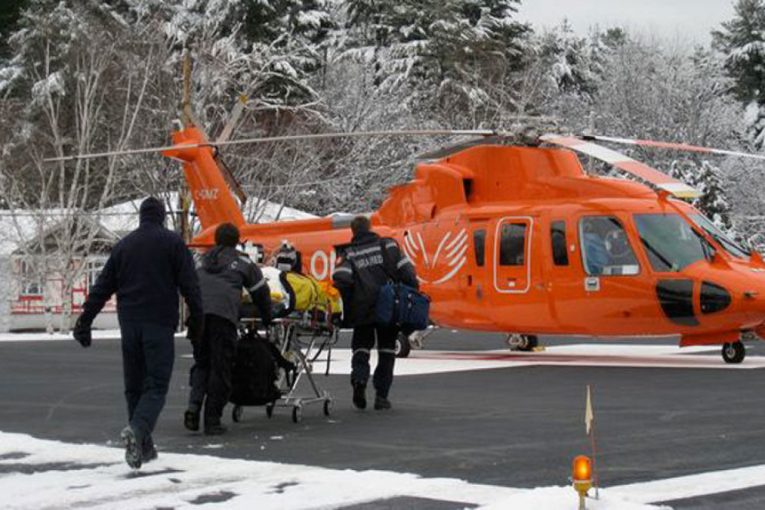
ORNGE caused the death of two pilots and two paramedics when the company failed to provide night vision goggles, the Crown attorney prosecuting Ontario’s air ambulance service has told a court.
“Despite knowing that flight into total darkness was their No. 1 workplace risk, ORNGE did not give these pilots any way to see in the dark or to see the ground,” prosecutor Nick Devlin told the judge presiding over the labour code case.
More than four years have passed since the 2013 crash that killed ORNGE captain Don Filliter, co-pilot Jacques Dupuy and flight paramedics Chris Snowball and Dustin Dagenais. They died shortly after taking off from Moosonee, Ont., headed to Attawapiskat.
In a hard-hitting condemnation of ORNGE’s safety and management regime at the time, Devlin never mentioned former boss Chris Mazza, but one of his decisions was front and centre: buying 12 state-of-the-art Italian helicopters and outfitting only 10 for air ambulance use. The plan — a failed one, as it turned out — was to one day sell the other two choppers for a profit. That purchase and related matters are part of an almost six-year-old OPP criminal probe, which, despite a statement by the force in March that it was nearing conclusion, now shows no sign of ending.
“ORNGE spent millions of dollars on a money-losing, speculative purchase of non-(air ambulance) aircraft, rather than using those funds to install (night vision) capacity in its fleet,” Devlin said in his submission to court. The helicopters were purchased from AgustaWestland at a cost of $144 million in 2008. Mazza and other senior company executives were gone by early 2012.
The air ambulance firm, which receives $172 million a year from the province, “failed the four men it sent out into the darkness,” Devlin said.
Though it involves the high-pressure field of emergency medical transport by air, the case in Brampton court is in essence a workplace safety case, and the prosecution is taking place under the Canada Labour Code. The maximum penalty against a corporation is a $1-million fine — something that has struck observers as odd, since if a penalty is paid, it will in effect come from Ontario taxpayers.
ORNGE has rejected Devlin’s claims, along with additional allegations that the two pilots were not properly trained or prepared for the flight.
“The pilots had the training, testing, and experience they needed to fly by instruments,” ORNGE said in its submission to court Friday, prepared by lawyers Brian Gover and Fredrick Schumann. “In those circumstances, the employer complied with its duty to ensure employee safety.” The lawyers pointed out that aircraft regulators in Canada do not require pilots to be able to see the ground.
ORNGE, in the wake of the crash, is in the process of outfitting its fleet and pilots with night vision capability.
The job ORNGE was doing in Moosonee, a northern community near James Bay, was routine for the service, which is charged with picking up patients in emergencies and flying others between hospitals. Filliter and Dupuy were flying an older model Sikorsky chopper, not one of the brand new AW139s that Mazza, as ORNGE boss, had purchased.
Neither type of helicopter was outfitted for night vision, though they had instruments that ORNGE maintains were sufficient for a safe flight.
The Transportation Safety Board investigation of the crash found that shortly after midnight on May 31, 2013, the ORNGE chopper was dispatched from Moosonee to Attawapiskat to pick up an emergency patient. Investigators determined the aircraft climbed to 300 feet and the captain and first officer began carrying out post-takeoff checks. The paramedics on board likely would have been preparing for the medevac ahead in Attawapiskat.
What was described as an “inadvertent descent” began as the chopper was banking left. During the turn, the captain noticed on the instruments that the turn angle was excessive and the first officer said he would correct it. Seconds before impact, the report states the captain “recognized that the aircraft was descending and called for the first officer to initiate a climb.” It was too late and the Sikorsky hit the ground, crumpling and bursting into flames.
Night vision goggles, court heard, would have made it possible for the pilots to quickly orient themselves with the terrain.
ORNGE spokesperson James MacDonald said that the air service is now fully operational with night vision goggles and modified aircraft at its bases in Sudbury, Kenora and Thunder Bay. ORNGE is aiming to have night vision capability in all chopper bases by the end of 2017.
The court case has also delved into the previous management at ORNGE. Prosecutor Devlin said in his submission to court that ORNGE was “run by people with little or no relevant experience,” that three safety warnings concerning the Moosonee pilot’s state of mind, readiness and training were ignored, and that ORNGE had a “corporate culture of ignoring, attacking and ostracizing pilots and managers who expressed safety concerns.”
ORNGE today is under different management, following a series of investigative stories by the Star that led to a massive overhaul of the agency and most senior-level executives being shown the door.
As to the ongoing OPP criminal investigation of Mazza and others over alleged kickbacks and other matters, OPP officials did not return requests for comment last week. On Sunday, a media official with the OPP said an update would be provided this week.
Mazza, a doctor, has bounced around various jobs in Ontario since leaving ORNGE. Once paid millions of dollars a year as a top executive, he has worked at a northern hospital in the emergency room and recently has been doing a stint as a sports medicine doctor in Mississauga.
You can read more of the news on source



